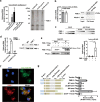Interferon-inducible cytoplasmic lncLrrc55-AS promotes antiviral innate responses by strengthening IRF3 phosphorylation
- PMID: 31213650
- PMCID: PMC6796909
- DOI: 10.1038/s41422-019-0193-0
Interferon-inducible cytoplasmic lncLrrc55-AS promotes antiviral innate responses by strengthening IRF3 phosphorylation
Abstract
Type I interferon (IFN-I) production is efficiently induced to ensure a potent innate immune response to viral infection. How this response can be enhanced, however, remains to be explored. Here, we identify a new cytoplasmic long non-coding RNA (lncRNA), lncLrrc55-AS, that drives a positive feedback loop to promote interferon regulatory factor 3 (IRF3) signaling and IFN-I production. We show that lncLrrc55-AS is virus-induced in multiple cell types via the IFN-JAK-STAT pathway. LncLrrc55-AS-deficient mice display a weakened antiviral immune response and are more susceptible to viral challenge. Mechanistically, lncLrrc55-AS binds phosphatase methylesterase 1 (PME-1), and promotes the interaction between PME-1 and the phosphatase PP2A, an inhibitor of IRF3 signaling. LncLrrc55-AS supports PME-1-mediated demethylation and inactivation of PP2A, thereby enhancing IRF3 phosphorylation and signaling. Loss of PME-1 phenocopies lncLrrc55-AS deficiency, leading to diminished IRF3 phosphorylation and IFN-I production. We have identified an IFN-induced lncRNA as a positive regulator of IFN-I production, adding mechanistic insight into lncRNA-mediated regulation of signaling in innate immunity and inflammation.
Conflict of interest statement
The authors declare no competing interests.
Figures








Comment in
-
Lnc(ing) interferon production and action.Cell Res. 2019 Sep;29(9):690-691. doi: 10.1038/s41422-019-0207-y. Cell Res. 2019. PMID: 31337876 Free PMC article. No abstract available.
Similar articles
-
IRF3-binding lncRNA-ISIR strengthens interferon production in viral infection and autoinflammation.Cell Rep. 2021 Nov 2;37(5):109926. doi: 10.1016/j.celrep.2021.109926. Cell Rep. 2021. PMID: 34731629
-
Fine-Tuning of the RIG-I-Like Receptor/Interferon Regulatory Factor 3-Dependent Antiviral Innate Immune Response by the Glycogen Synthase Kinase 3/β-Catenin Pathway.Mol Cell Biol. 2015 Sep 1;35(17):3029-43. doi: 10.1128/MCB.00344-15. Epub 2015 Jun 22. Mol Cell Biol. 2015. PMID: 26100021 Free PMC article.
-
KAT8 selectively inhibits antiviral immunity by acetylating IRF3.J Exp Med. 2019 Apr 1;216(4):772-785. doi: 10.1084/jem.20181773. Epub 2019 Mar 6. J Exp Med. 2019. PMID: 30842237 Free PMC article.
-
RNA helicase DDX5 suppresses IFN-I antiviral innate immune response by interacting with PP2A-Cβ to deactivate IRF3.Exp Cell Res. 2020 Nov 15;396(2):112332. doi: 10.1016/j.yexcr.2020.112332. Epub 2020 Oct 13. Exp Cell Res. 2020. PMID: 33065113
-
Recruitment of phosphatase PP2A by RACK1 adaptor protein deactivates transcription factor IRF3 and limits type I interferon signaling.Immunity. 2014 Apr 17;40(4):515-29. doi: 10.1016/j.immuni.2014.01.015. Epub 2014 Apr 10. Immunity. 2014. PMID: 24726876
Cited by
-
Grass Carp (Ctenopharyngodon idella) KAT8 Inhibits IFN 1 Response Through Acetylating IRF3/IRF7.Front Immunol. 2022 Jan 3;12:808159. doi: 10.3389/fimmu.2021.808159. eCollection 2021. Front Immunol. 2022. PMID: 35046960 Free PMC article.
-
LincRNA-EPS impairs host antiviral immunity by antagonizing viral RNA-PKR interaction.EMBO Rep. 2022 May 4;23(5):e53937. doi: 10.15252/embr.202153937. Epub 2022 Mar 21. EMBO Rep. 2022. PMID: 35312140 Free PMC article.
-
Therapeutic efficacy of a novel self-assembled immunostimulatory siRNA combining apoptosis promotion with RIG-I activation in gliomas.J Transl Med. 2024 Apr 29;22(1):395. doi: 10.1186/s12967-024-05151-5. J Transl Med. 2024. PMID: 38685028 Free PMC article.
-
[Non-Coding RNA and Innate Immune Signal Regulation].Sichuan Da Xue Xue Bao Yi Xue Ban. 2022 Jan;53(1):20-27. doi: 10.12182/20220160202. Sichuan Da Xue Xue Bao Yi Xue Ban. 2022. PMID: 35048595 Free PMC article. Review. Chinese.
-
Regulation of antiviral innate immune signaling and viral evasion following viral genome sensing.Exp Mol Med. 2021 Nov;53(11):1647-1668. doi: 10.1038/s12276-021-00691-y. Epub 2021 Nov 16. Exp Mol Med. 2021. PMID: 34782737 Free PMC article. Review.
References
Publication types
MeSH terms
Substances
LinkOut - more resources
Full Text Sources
Molecular Biology Databases
Research Materials

